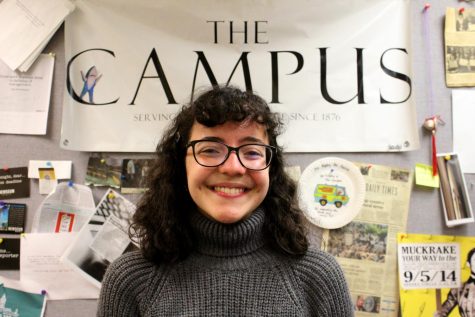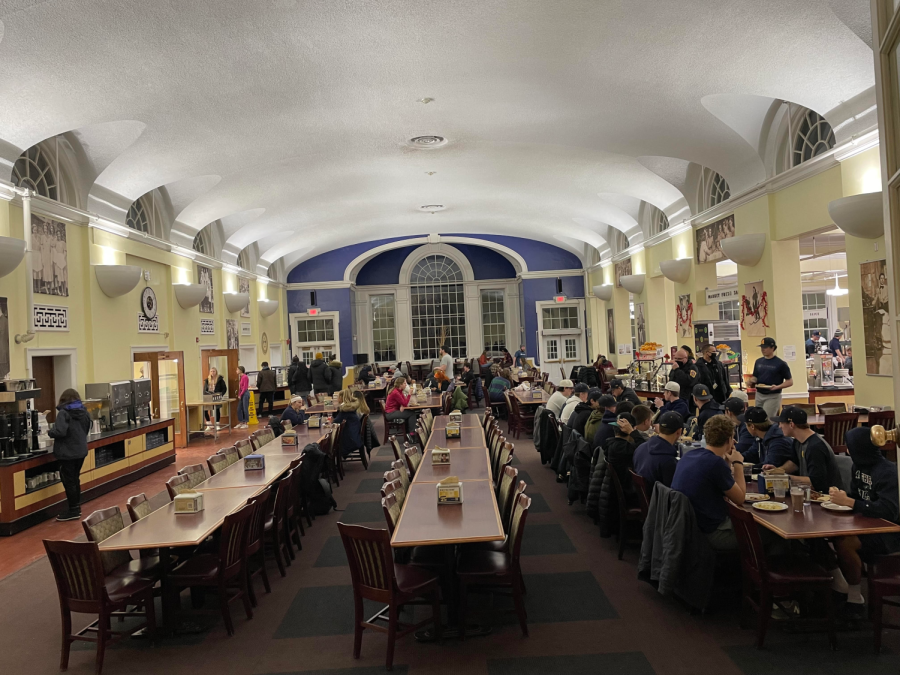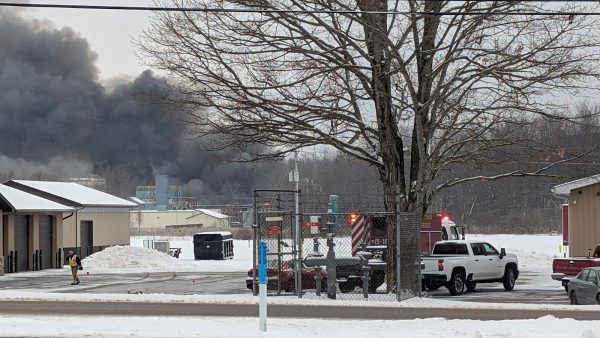Snowstorm, staff shortage, and all-you-can-eat: campus dining post-winter break
Brooks opens for dinner on Jan 26. With the all-you-can-eat system, students cannot use their Green Boxes at the tables, unlike what was commonplace before.
On Monday, Jan. 17, students tapped through their Instagram stories to come across a series of story posts from the Parkhurst-run @alleghenydining account: Pastasciutta, the all-mobile pasta station at McKinley’s Food Court, would be closed that day. Also down was the sauté area at Brooks Dining Hall. Going into either dining hall confirmed the news — the stations were empty for the duration of the day. In addition, Firehouse Grill at McKinley’s had to stop business later that afternoon as well.
The reason behind these shutdowns — the snowstorm that had hit the day before.
“We had 22 of our staff members not be able to make it into work that day, just getting stuck, they can’t get their cars out,” said General Manager for Parkhurst Dining Stephanie Lang. “Some of our team are walkers, so without sidewalks being cleared, we didn’t want them walking up the middle of the road . . . there was concern that they wouldn’t be able to get home at the end of the night. We really appreciate our team (members) who did come in that day.”
With this many workers not on campus, adjustments had to be made. That included closing the deli at lunchtime and the pizza and pasta station at dinnertime as well.
This snowstorm compiled an already-existing issue, according to Lang.
“I think there’s a lot of challenges particularly for hospitality right now,” Lang said. “Even though we’re still in (the pandemic), there’s still that irrational fear that tomorrow we could be shut down, or tomorrow we could have to go takeout only . . . and then on social media a lot of times you see how badly people in hospitality are treated, and I think that really discourages people from coming back to our business.”
According to Lang, this is not a problem unique to Meadville. The Parkhurst company spans across 14 states, and company-wide, similar issues have been arising in terms of staffing. For Allegheny, Lang spoke about having to lay off workers during the holiday season and how that temporary loss of income while Allegheny is not in session can be difficult for a family.
Lang had the exact figures for how many staff members she was short of, which she admitted did not bode well. The hiring process, however, is ongoing.
“Currently, at McKinley’s, I have 11 positions vacant out of 38, and at Brooks I have five positions vacant out of 46,” Lang said. “There are a few people in the hiring process, so not to say that it sounds worse than it is, but (on) the other hand it is pretty bad. We’re really working hard to get people hired.”
The vacancies at Brooks do not appear to have any negative impacts on the new all-you-can-eat system there, although they have meant that things look different compared to the original system of this nature, which had to be nixed in favor of the points program when COVID-19 disrupted operations in the spring of 2020.
One major difference between the two all-you-can-eat programs, as Daisy McKim — the social media coordinator for Parkhurst — explained on an @alleghenydining Instagram story post, was that the “old system required us to have a team member upstairs all day to swipe every student in and out. With staffing shortages, it is not possible for us to dedicate a team member to have this job at this time.”
Those who have eaten at Brooks Dining Hall since this program was put back in place will know that they have to swipe at one of the stations first, and after swiping there, they may go to any station and show confirmation of that swipe via the GET Mobile app to get additional food at that station. One swipe at any one station lets students have as much food as they would like during the meal period.
Another way in which the new and old all-you-can-eat systems differ is that a team member serves students at every station. Students cannot serve themselves, whereas they could before. At every station save for Spoon and Fork, students could get their food on their own.
Initially, as Lang put it, team members were “terrified” at the prospect of returning to all-you-can-eat because of the original self-service nature of the system.
“They were very nervous about the quantity of food that they would be producing,” Lang said. “They were concerned about the waste, which we haven’t really seen how that’s going to play out yet … but they’re really happy they don’t have to deal with the tickets anymore, so they’re cautiously optimistic.”
Veronica Green, ’23, a student employee for Parkhurst, explained that the new system has pros and cons. Green started working with Parkhurst catering under Director of Catering Tony Pollock, but now serves in a multitude of capacities at Brooks Dining Hall. She remarked that while students can make more out of their meal plan, the new system puts extra pressure on staff.
“I worked one of the first shifts with the new all-inclusive menu the weekend that all of the students came back, and it was a lot different than when I would serve last semester with the punch program that we had,” Green said. “You’ve got to work a lot faster now. It’s also hard because you’ve got to also wait for people to show you whether or not they’ve punched in other stations. And by the time you’ve finished with the first wave of people, people are coming up for their second plate . . . it’s a never-ending flow.”
If students are interested in working for Parkhurst, they can reach out to Maria Foxall at mfoxall@allegheny.edu.

Sofia Hassan is a second-year student from New Castle, Pennsylvania. She plans to major in English Creative Writing and minor in Middle East and North...











Al Coppolo • Jan 29, 2022 at 8:00 am
Are there too many options? When did feeding students become so complicated? From 1974 – 1978 there were three venues on campus for student dining – South Hall, Brooks, and Skylight (3rd floor Campus Center). Breakfast for everyone was only available at Brooks. Students were assigned to one of the three dining halls (full semester) for lunch and dinner. You had a 90 minute window to get your meal, then the dining hall closed. Students would show their student ID when they entered the hall. It would be checked manually against a master list of authorized students and then you’d be let in. It was classic cafeteria style dining – no stations. If you wanted seconds, you simply got back in line with your plate and waited your turn. It was simple and it worked. Yes, at some time or another, everyone complained about the food, but then that’s part of the college experience. Why is it so hard to feed students today? Do they expect too much? Have we made it too complicated in an effort to compete with other schools and retail establishments? It is painful to watch so much effort spent on an activity that can be so simple and yet still fulfilling.
Al Coppolo ‘78